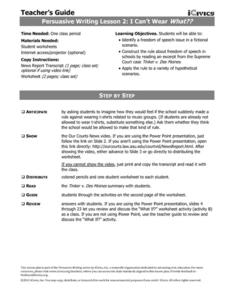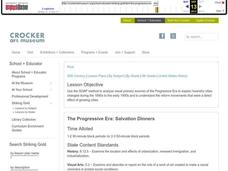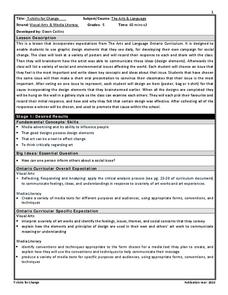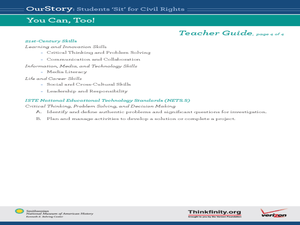iCivics
I Can’t Wear What?
Can schools ban t-shirts picturing musical groups or bands? Your young citizens will find out with this resource, which includes a summary of a United States Supreme Court case from the 1960s about a similar dispute over students wearing...
Curated OER
The Progressive Era
Eighth graders utilize the SOAP method to analyze a work of art and relate it to what they know about the Progressive Era and the reasons why cities changed and the ways in which cities changed during the end of the 19th century. They...
Curated OER
A River Ran Wild: An Environmental History
The Nashua River serves as the focal point of an investigation of the treatment of and care for natural resources. A reading of A River Rand Wild: An Environmental History by Lynne Cherry, launches the study and class members consider...
Curated OER
T-shirts for Change
Can school children change the world? With a social or environmental issue in mind, 5th graders use what they know about advertising media to make t-shirts that have something to say. They research the issue they'd like to focus on,...
Center for Civic Education
The Power of Nonviolence: Music Can Change the World
Here is a fantastic activity through which class members discover how music has the ability to influence others in a meaningful way. After reviewing selected pieces and modern-day protest songs, learners will research other songs that...
Administrative Office of the US Courts
Texas v. Johnson
Which right does the Constitution weigh more heavily: the sanctity of the American flag as a symbol of national unity, or the right to burn the flag in protest? The 1989 Supreme Court case of Texas v. Johnson explores a state's right to...
Reed Novel Studies
Flush: Novel Study
Standing up for beliefs sometimes leads to trouble! The father in Flush takes knows this all too well when he sinks a boat in protest to its illegal dumping. With his dad behind bars, the son, Noah, takes matters into his hands by...
Curated OER
Our Story: Martin Luther King Jr. and Nonviolence
In this parent and child activity, young learners read Martin’s Big Words and a biography of Dr. Martin Luther King Jr. There is a wonderful guided reading pdf that defines challenge words and provides reading tips. The object of this...
Curated OER
The Two-Party System: Chapter 5
Guide your students' reading with this worksheet. Included are five matching and five multiple choice questions focused on aspects of the two-party system employed in the United States. Use as a quiz, guided reading questions, or homework.
Curated OER
A Day for Choosing Revolution
Young scholars read contemporary news articles about public protest. They describe a form of protest that took place in 18th-century Virginia. Students compare events or ideas that people protest about today to events or ideas protested...
Curated OER
The Vietnam War
Students discuss the nature of protest. They comprehend that art can be a form of protest. Students analyze how music was used as a powerful tool for speaking out against the war. They listen to some protest music and discuss the meaning...
Curated OER
Bloody Mary Word Search
In this word search worksheet, students study the words related to Bloody Mary. Students locate the 15 words within the word search puzzle.
Curated OER
Storytellers: Pearl Jam, New Twist on an Old Song
Students examine the use of music as a medium for social protest. They watch the video, "VH1 Storytellers: Pearl Jam," describe the historical significance of words/phrases in three versions of one song, and answer discussion questions.
Curated OER
Immigration Across the Nation
Students examine the nationwide immigrants' rights demonstrations. They research and discuss proposed legislation leading up to the demonstrations.
Curated OER
Vietnam War
Students explore the Vietnam War. In this wartime culture lesson, students use primary sources to examine the impact of protests and the draft during the Vietnam War. Students create informational posters based on their findings.
Curated OER
The Gunpowder Plot
In these Gunpowder Plot worksheets, students read about the Gunpowder Plot of 1605. Students read the facts, the Catholic view, and the Protestant view.
Curated OER
You Can, Too!
Young scholars and their parents participate in a volunteer opportunity in their community in order to solve a problem. In this problem solving lesson plan, students reflect on historical problems and see how they can solve a current...
Curated OER
Man in Conflict - Vietnam and Literature
Eleventh graders analyze the lyrics of protest music. In this Vietnam War lesson, 11th graders examine conflict as they consider the controversial nature of the war as evidenced in song lyrics. Students also consider the Iraq War and its...
Curated OER
Anti-Vietnam War Movement Lesson
Students examine reasons why many Americans opposed the Vietnam War. In this world history lesson, students view a Powerpoint of anti-war images and a timeline of events that led to the war. Students examine speeches made by John Kerry...
Curated OER
Lincoln's Spot Resolutions
High schoolers examine the controversy and varying points of view leading up to the 19th century Mexican War. They research examples of anti-war movements throughout history and write editorials about their findings.
Curated OER
The Role of Protest Songs
tudents will illustrate the role, significance, and history of protest songs from the African American Civil Rights Movement. They will verbally answer the question: "What is the link between the Civil Rights Movement and Hip Hop music...
Curated OER
Breaking News English: Iraq War Protests in Washington DC
In this English worksheet, students read "Iraq War Protests in Washington DC," and then respond to 47 fill in the blank, 7 short answer, 20 matching, and 8 true or false questions about the selection.
Curated OER
When Youth Protest: Student Activism and the Mississippi Civil Rights Movement, 1955-1970
Students explain the meaning of the following terms associated with the modern Civil Rights movement: segregation; integration; civil rights; civil disobedience.
Curated OER
Political Protest Through Art
Students examine how artists (painters or cartoonists) use artwork as a means of disseminating a political point of view in this lesson that uses primary source documents and examples of political cartoons.

























